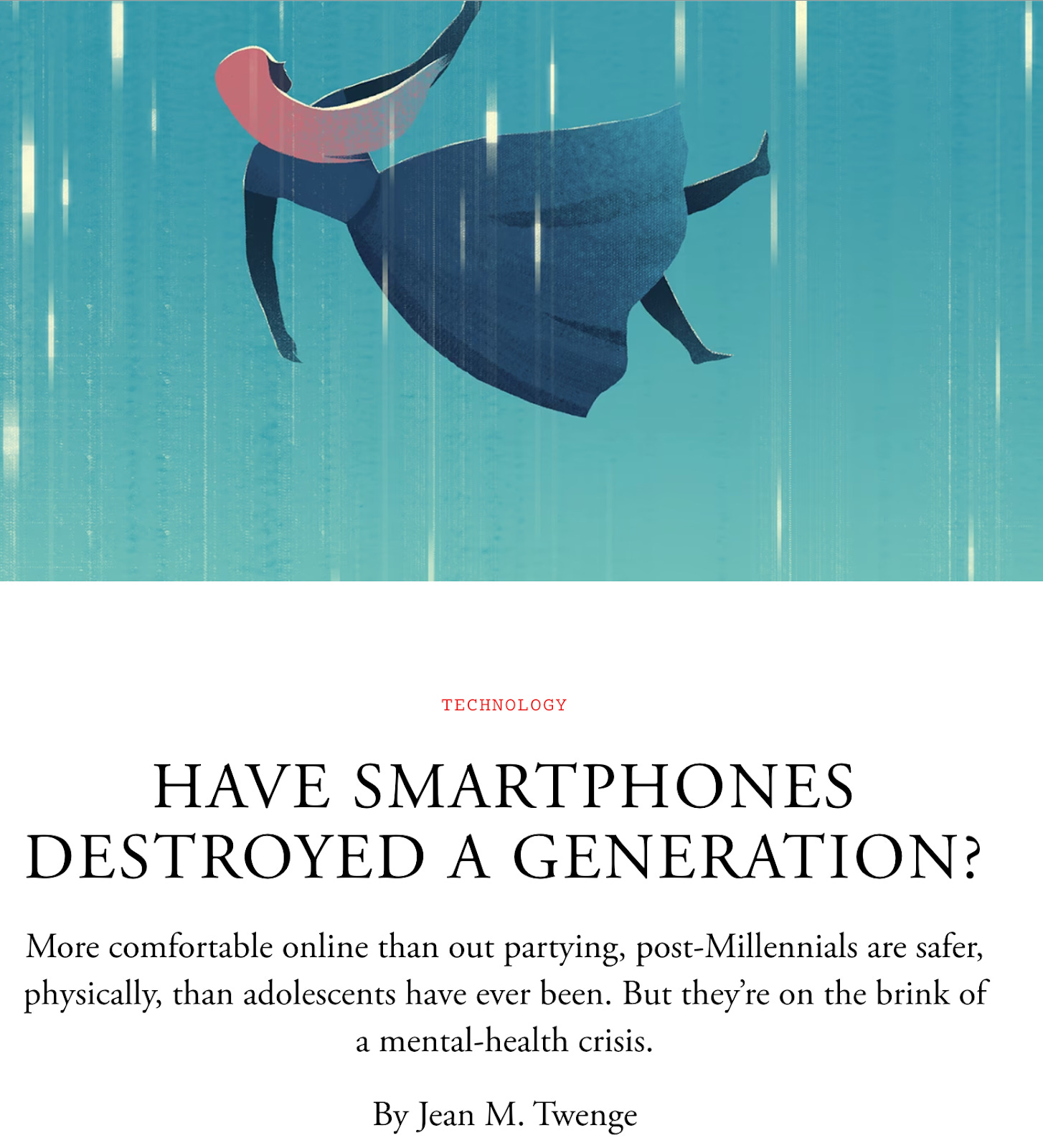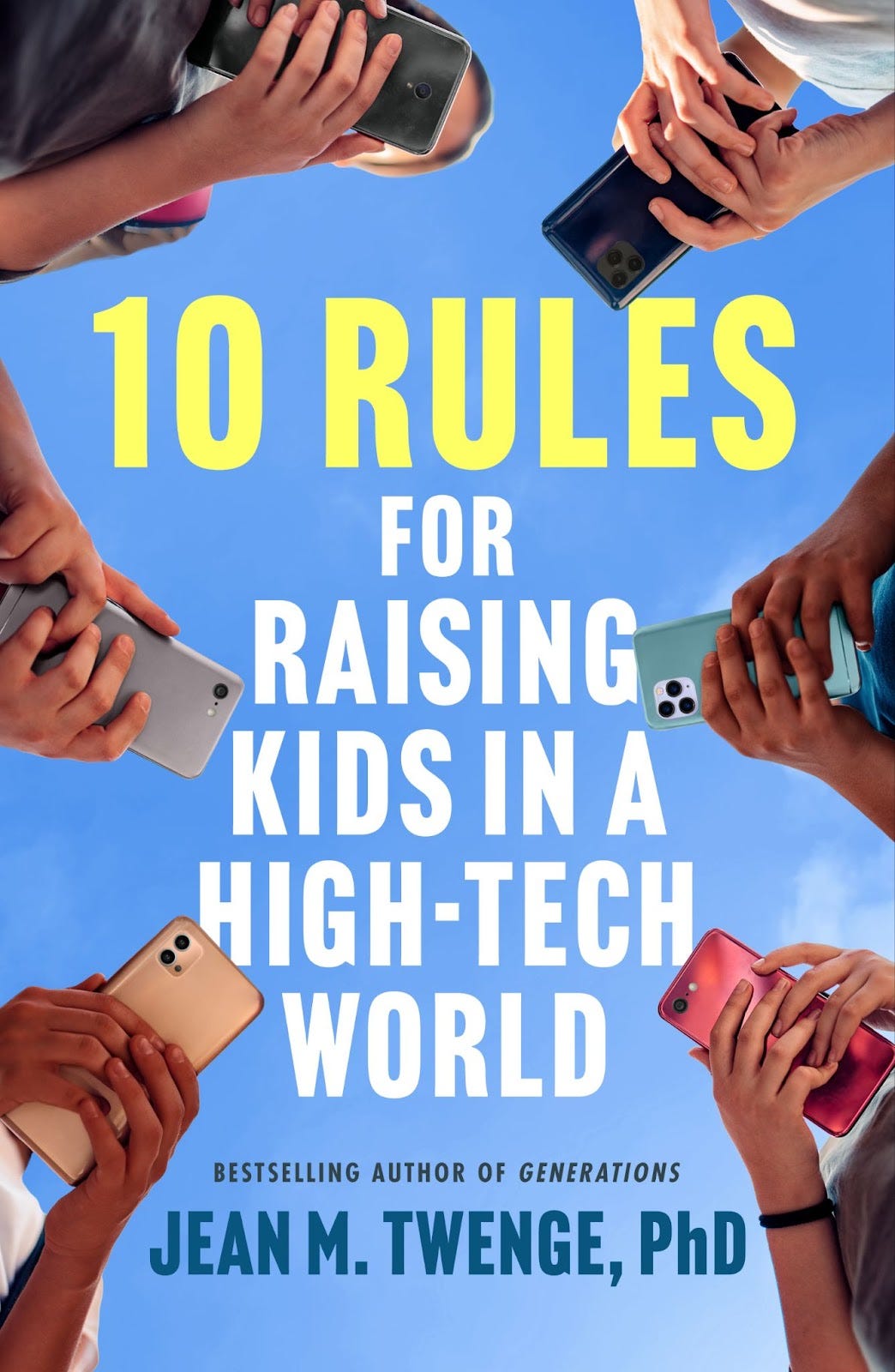Basic Phones: A Guide for Parents
An Excerpt From Jean Twenge’s New Book: 10 Rules for Raising Kids in a High-Tech World
Intro from Jon Haidt:
America and the world now see the dangers of a phone-based childhood, and that is in part thanks to an article published in The Atlantic almost exactly eight years ago: Jean Twenge’s blockbuster essay Have Smartphones Destroyed a Generation? The article was excerpted from her soon-to-be-released book iGen, which laid out the statistical case that something had changed, something was going wrong for adolescents born after 1995. Measures of independence and maturation were dropping (fewer teens were getting driver’s licenses, getting part time jobs, trying alcohol, or entering romantic relationships). Meanwhile, measures of poor mental health were rising very quickly and suddenly, beginning around 2012, after years of relatively little change.
Jean took a lot of heat for suggesting that these troubling trends might be linked to the rapid switch from basic phones to smartphones loaded with social media apps in the early 2010s. Several researchers who studied the effects of video games and social media accused her of fueling a moral panic by exaggerating small effects and mistaking correlation for causation. But time has largely vindicated Jean. The trends have only kept growing, and many kinds of evidence now show that social media in particular is causing harm — including the many statements and studies we now have from inside social media companies. Jean deserves credit for waking the world up to the digital dangers that just keep coming for our kids (Chatbot Barbie? Chatbot suicide coaching?)

I began working with Jean in 2019, after my 2018 book The Coddling of the American Mind put me into the debate over kids and screens. Together, we published several papers critiquing some of the most-often cited studies used to argue that social media is harmless.
As the evidence of harm continued to mount, we both wrote books to help parents protect their children. Jean’s new book, published today, goes much further than mine in offering specific, practical advice to parents. Her title says it all: 10 Rules for Raising Kids in a High-Tech World: How Parents Can Stop Smartphones, Social Media, and Gaming from Taking Over Their Children's Lives. Based on her research and her experience as a mother of three teenagers, the book gives parents a roadmap to protect children without cutting them off from technology and each other. If you can apply even a few of these ten rules, you'll likely have a happier family and healthier kids.

Readers of After Babel will already be familiar with Jean’s writing. Her own Substack, Generation Tech, is a must-read for parents and researchers, and we have featured some of her most important posts, such as Here are 13 Other Explanations for the Adolescent Mental Health Crisis. None of Them Work. Today, we are pleased to bring you an excerpt from Jean’s new book, a shortened version of Rule 4: First phones should be basic phones.
— Jon Haidt
Basic Phones: A Guide for Parents
By Jean Twenge
In 2021, Common Sense Media found that half of U.S. kids get their first smartphone by age 11. Many parents now realize that age is too young for kids to have an internet-enabled phone.
But at some point, you’re going to consider getting your kid or teen a phone. Maybe the closest school bus stop is far away and the bus isn’t always on time. Maybe you’re sick of your kid borrowing your phone to text their friends. Maybe they’re getting older and it seems like the right time. So what type of phone should you get them?
In some cases, the answer might be a flip phone, the old-school cell phone that was the standard until the smartphone came along. Flip phones have some downsides, though. Since there’s no keyboard, texting involves pressing the number keys multiple times to type one letter (if you had a cell phone in the 2000s, you probably remember this). If your kids’ friends communicate via text, replying on a flip phone is going to be awkward and time-consuming. Flip phone cameras are often low-quality, so they’re not a great option if your kid likes taking pictures. Because they don’t look like a smartphone, flip phones also stand out — and many kids don’t want to stand out.
Fortunately, parents no longer have to choose exclusively between a flip phone and an adult smartphone for their kid, thanks to the many “basic” phone options. These middle-ground phones have a screen keyboard and a higher-quality camera like a smartphone, look very similar to a smartphone, and they can use many smartphone apps (with parental limits and permissions). Unlike a regular smartphone, though, they don’t have an internet browser or social media.
Basic phones are the training wheels of phones. They’re safer for kids right out of the box, with built-in parental controls that are easier to use and harder for kids to hack than those on smartphones. With no internet or social media, it’s much less likely that unknown adults will be able to randomly contact your kid, or that kids will stumble across pornography. Basic phones are usually Androids with a modified operating system, so they look like a regular smartphone and thus don’t stand out like flip phones do. For all of these reasons, Rule #4 in 10 Rules for Raising Kids in a High-Tech World is “First phones should be basic phones.”
If you want your kid to have the ability to easily text their friends but don’t want them using social media or going down internet rabbit holes, basic phones are a great solution. They’re a stopgap between the age when texting and calling becomes socially useful (usually in middle school, by age 12 or 13) and the age when they’re ready for a smartphone and possibly social media (at 16; Rule #5 in 10 Rules is “Give the first smartphone with the driver’s license,” and Rule #3 is “No social media until age 16 – or later.”). My younger two children, ages 15 and 13, have basic phones.
Here’s a brief overview of some popular basic phone options to help you figure out the best choice for your kid.
Option 1. Gabb Phone 4
This is the most basic of the basic phones, with calling, texting (including text-to-speech), clean music streaming, and a camera, but no capability for adding additional third-party apps. “You can’t do anything on it,” my middle daughter once said about her Gabb phone. “That,” I replied, “is the point.” If this is what you want, make sure you’re buying the Gabb Phone 4 and not the Pro, which allows more apps.
Option 2. Pinwheel, Troomi1, Gabb Phone 4 Pro, Bark
These are basic phones that have access to an app store where you can add additional features. They come with an online parent portal where you can set a schedule (like having the phone shut off at bedtime) and approve new contacts. Some allow you to see the texts your child has received and sent.
The parent portal also lets you see the apps available for the phone. You can then install those you want and approve (or reject) those your kids ask for. These phones don’t allow certain apps at all (mostly dating, pornography, and alcohol-related apps, as well as AI chatbots and those that allow contact with unknown adults). That’s a relief, but there are still tough decisions about what to allow versus not. The tradeoff for more flexibility is more complexity in managing the phone. Still, I’d much rather have this challenge than giving a 12-year-old a smartphone with unrestricted internet and social media access.
Through the parent portal, you also have the ability to remotely control bedtime shutoff, app installs, and time limits for apps even after you’ve given your kid the phone — so you don’t have to wrestle it away from them to change your parental control settings.
If you’re looking for more details about specific basic phone brands for kids, check out the pages at Wait Until 8th and Protect Young Eyes.
Option 3. The Light Phone
This is a grown-up basic phone. Unlike other basic phones, it’s not necessarily meant for kids, and it’s not an Android phone — it’s a unique device. It has a paper-like screen like a Kindle so it’s not as colorfully tempting as a smartphone. It has a maps app, calling, and texting, but does not have internet access, social media, or email. The newest version has a camera. All of the features are optional so you can choose which features your kid’s phone has.
Many adults who want a pared-down phone, sometimes just for certain situations, use Light Phones. Because their target audience is adults, Light Phones do not come with a parent portal like the phones designed for kids.
The biggest challenge with basic phones (with the exception of the more limited Gabb Phone 4) is deciding which apps to allow. The parent portals that come with many of these products give more information and sometimes even a rating for each app, but it’s often hard to judge what’s appropriate and what isn’t without using the app yourself (something to consider). If you allow game apps, make sure to put a time limit on them (maybe 10-20 minutes a day each) so your kid doesn’t spend too much of their free time on their phone.
One other issue to be aware of: All of these optional apps display ads, and the ads – even on a so-called “kids’ phone” – are not filtered. Your kid might be playing “Find the Cat” and be served ads for AI girlfriends. They won’t be able to download the AI girlfriend app, thank goodness, but you may find yourself explaining what an AI girlfriend is to an 11-year-old. If that’s a non-starter, you’ll have to say no to any optional app, including games and educational apps like Duolingo.
If you do allow games and music, use the parental controls to block them during school hours if your kids’ school still allows phones during the school day. That way you’ll know your kids are paying attention in class instead of playing BlockBlast. And if they say they want to play games during lunch, tell them they should be talking to their friends instead.
What if your kid says, “It’s embarrassing to have a kid phone”? My reply: Who’s going to know? Most basic phones look like a regular Android phone. My middle daughter once told me she was embarrassed when a friend asked her, “What kind of phone is that?” I told her she could honestly answer, “It’s an Android phone.” There’s also no need to disclose that the phone doesn’t allow social media or internet. If your friends ask if you have a certain app and you don’t, I told her, just say your parents don’t allow it. All kids understand that parents are lame. :)
Full disclosure: I serve on the Advisory Board for Troomi.



I'm 41, and it seems that the Light Phone is ideal for me (I do use the Maps App quite often).
Please somebody make a quality flip phone with a high quality camera and voice recognition for texting. This rugged format is by far the best for actual voice communication, positioning microphone and speaker appropriately, and making the answering and hanging up functions easily navigated in the dark rather than a mess of floating icons where it is hard to find the phone function.